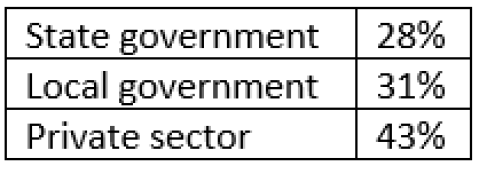Widgetized Section
Go to Admin » Appearance » Widgets » and move Gabfire Widget: Social into that MastheadOverlay zone
Employee Engagement – Is It Really A Priority?
The views expressed are those of the author and do not necessarily reflect the views of ASPA as an organization.
By Robert Lavigna
June 1, 2018
Results from two research studies on the public sector workforce have revealed perplexing and seemingly contradictory results. According to one study, government human resources leaders believe that focusing on employee engagement is a high priority. However, other research reveals that engagement among government employees is low. These results are not only contradictory, they’re alarming. If engagement is important, why is it low?
The first study was jointly conducted by the Center for State and Local Government Excellence (CSLGE), the International Public Management Association for Human Resources (IPMA-HR) and the National Association of State Personnel Executives (NASPE). I know that’s a mouthful, but it’s a formidable alliance. Their report is entitled, “State and Local Government Workforce: 2018 Data and 10 Year Trends.” I’ll refer to it as the CSLGE report.
In this research, CSLGE polled public sector HR leaders and professionals across the country who are members of IPMA-HR and NASPE. I am a past president of the former and was a member of the latter when I was director of the state of Wisconsin civil service system. About 95 percent of the 337 poll respondents work in state and local government.
One poll question was, “Looking ahead, which workforce issues are important to your organization?” About 79 percent of the respondents listed “employee engagement,” while 81 percent selected engagement’s cousin, “employee morale.” Only “recruitment and retention of qualified personnel with needed skills for public service” and “competitive compensation package” (82 and 80 percent, respectively) scored higher.
So, according to these HR leaders, employee engagement is among their organizations’ most important priorities.
However, this finding conflicts with other research, including by my organization, the Institute for Public Sector Employee Engagement, showing that employee engagement in government is low. Our national poll, conducted most recently in 2017, found the percentages of fully engaged employees in state and local government, and the private sector, are:

It’s not hard to understand why the level of full engagement is lower in government, given the persistent criticism of the public sector. It can be hard for public servants to feel good about their jobs when their work and organizations are continually disparaged.
 Decades of research have proven that high engagement can drive high performance. This can then drive citizen satisfaction and confidence in government. When government employees believe that the people they serve have confidence in the work they do, these public servants are more likely to be engaged — A virtuous cycle.
Decades of research have proven that high engagement can drive high performance. This can then drive citizen satisfaction and confidence in government. When government employees believe that the people they serve have confidence in the work they do, these public servants are more likely to be engaged — A virtuous cycle.
This is why employee engagement is not just another management fad. It’s about performance and service delivery.
Engagement can also enable government to attract and retain talent. As the CSLGE survey revealed, recruitment and retention of talent is a top priority. Government organizations that create the conditions for their employees to feel good about their work (i.e., be engaged) can attract and retain talented people.
Government service used to be a respected profession. The best and brightest aspired to make a difference by devoting their careers to public service.
These days, however, government’s many critics seem to have lost sight of the vitally important work the public sector performs.
At the same time government is being castigated and hamstrung by budget cuts, and Americans continue to ask public servants to solve some of our toughest and most intractable problems: building the economy, sustaining a war that has stubbornly persisted for more than 15 years, protecting the public, maintaining the quality of life in our communities, eliminating poverty and homelessness, preserving the environment, expanding opportunity by improving our educational systems, providing affordable health care, and so on.
This is a sad paradox – attacking government and cutting budgets while also expecting government to maintain and improve performance. And solve problems other sectors can’t.
Decades of research have shown that a key way for government to respond to this enormous challenge is to improve employee engagement. This means measuring engagement through employee surveys, using the results to understand what drives employee engagement – and then taking action to improve it.
As I wrote in my book, Engaging Government Employees, free pizza and Coke on Friday afternoon is not an engagement strategy. Perks like this are nice but they will not, by themselves, build engagement. Nor will just focusing on compensation. Pay matters, but creating the conditions for real engagement requires more than fair compensation.
Government must make employee engagement a strategic priority. For example, here is how four public-sector organizations have explicitly described their commitment to engagement, in mission and strategic priority statements:
- Engaged and talented employees reflect our community, have the resources they need to succeed and are empowered to improve our efficiency and effectiveness;
- (We) Work directly with all departments to engage employees to improve government services for (our citizens).
- (Our goal is to) Maintain a dynamic and skilled workforce through employee engagement, professional development and opportunities for advancement;
- We are comprised of HR professionals dedicated to building an engaged workforce to make life better for all our residents, every day;
If engagement truly is important, as the CSGLE study suggests, public-sector organizations across the nation, including in state and local government, need to make it a strategic priority. Because if government does not attract, develop, engage and retain talent, it cannot be effective. The stakes are too high to let that happen.
Author: Bob Lavigna is director of the Institute for Public Sector Employee Engagement, a unit of CPS HR Consulting, an independent government agency. Previously, he was assistant vice chancellor and director of human resources for the University of Wisconsin and VP-research at the Partnership for Public Service. Email: [email protected].






Follow Us!